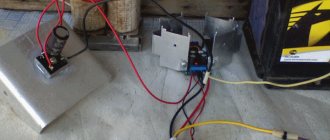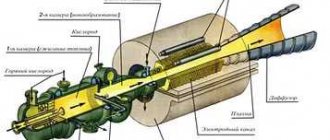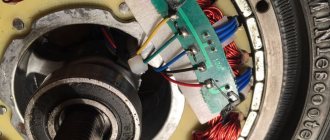Did you know that the first cars were electric and used lead-acid batteries? What we are accustomed to consider as the cars of the future - electric cars - appeared before the invention of the internal combustion engine (ICE). More than 100 years have passed since then, but the modern car battery has changed only qualitatively, remaining fundamentally the same as a century ago.
Today, a car battery is considered a consumable item that requires periodic replacement. Exactly how long the battery will last is a question of the quality of manufacture, operating mode, even the condition of the roads, but sooner or later it is replaced with a “fresh” one. What functions does it perform, what characteristics can it have, how to choose and how to extend the life of the battery - read in this article.
What is a battery (battery) and what is it for?
Modern cars are becoming more and more like complex electronic gadgets: smart controls, all kinds of “assistants”, automatic parking and even autopilot are only a small part of the digital “stuffing” that a car is rich in. And all this happiness constantly needs electricity, which must be constantly obtained from somewhere. It is the battery that acts as a storehouse of energy, from where it can be taken at any time. Yes, it performs its clear function: it accumulates a charge, then releases it and then accumulates it again. Great option!
The very concept of a battery is already so familiar to us that it is stupid to ask why it is needed. However, surprisingly few people can say exactly what a car battery does.
Its purpose can be described in three points.
- The battery provides the energy to start the engine at the start.
- The battery serves as a backup source of energy when it is needed beyond what the generator can provide (for example, when turning on the car's air conditioning).
- The battery powers electrical appliances when the engine is off and the generator is not running. For example, DVR, alarm, light, etc.
Purpose:
• The engine is not running.
Supplies electrical current to lights, radios and other electrical systems. • The engine starts. Electrical current from the battery is supplied to the spark plugs to start the engine.
• The engine is running. The battery acts as a voltage stabilizer when the generator produces more voltage than required. In the event that the generator cannot cope with the load, the battery makes up for the lack of voltage and is used as an alternative power source for electrical appliances.
Design and principle of operation of the battery
The structure of a car battery
Anyone who has ever held a car battery in their hands knows how much this device weighs. The reason is that its body is densely filled with elements containing lead.
Battery device.
For passenger cars requiring 12-volt batteries, a standard layout is used.
- Six 2-volt elements (usually called banks) are combined into a common housing.
- Each of the elements consists of positive and negative electrodes: lead grids into which the active substance is “imprinted”. The electrodes are separated from each other by separators, so that they do not come into contact with each other.
- And all this is filled with electrolyte - a mixture of water and sulfuric acid.
The active substance on the grids differs in composition: lead dioxide is used for the anode (positive electrode), lead sponge is used for the cathode (negative electrode). In both cases, auxiliary substances (ligatures) are added to the lead components to improve battery performance.
Principle of operation.
The principle of operation of the battery
In the form described above, the battery is considered “charged”. When any device that requires energy is connected to the battery terminals, the lead components react with sulfur oxide and water. Sulfur and lead react and transform into lead sulfate and water. There is less acid in the electrolyte, more water, the density of the electrolyte decreases and after some time the sulfur concentration is not enough to react with the lead components. The battery is running low.
Links
- [protect.gost.ru/v.aspx?control=7&id=146532 GOST 15596-82] “Chemical current sources. Terms and definitions" [protect.gost.ru/document.aspx?control=7&id=146532 Chemical current sources. Terms and Definitions]
- GOST R 53165-2008 [protect.gost.ru/document.aspx?control=7&id=174450 Lead-acid starter batteries for automotive vehicles. General technical conditions.] Instead of GOST 959-2002 and GOST 29111-91
- [www.mami.ru/science/autotr2009/scientific/article/s01/s01_24.pdf On the contradictions in the theory of operation of a lead-acid battery Ph.D., prof. Kochurov A. A. Ryazan Military Automotive Institute]
- [youtube.com/watch?v=4IgHj2Uim_0 Video demonstrating how the battery works] on YouTube
- [atlib.ru/wiki/akb-avtomobilnyj-akkumulyator-4 Causes and signs of battery failure]
Types of batteries
In an attempt to improve the performance of car batteries, engineers have tried many methods. As a result, today we have different types of batteries, which differ in the chemical composition of the active components and design.
Classification according to the composition of the active substance
The first batteries used lead plates, but this design quickly ceased to suit engineers and consumers: it was heavy, ineffective, and short-lived.
- The first improvement was the addition of antimony to lead, which greatly extended the life of the battery.
- The next stage is to reduce the percentage of antimony to the optimal concentration. This approach made it possible to create low-maintenance batteries: they required topping up water much less often.
- Then metallic calcium began to be used to coat the plates - this is how calcium batteries (aka Ca-Ca) appeared. Calcium has seriously changed the operating parameters of batteries: in previous models, water loss due to electrolysis at 12 V required constant topping up, and calcium alloys made it possible to increase this threshold to 16 V. Thanks to this, it became possible to make maintenance-free batteries in a completely sealed, non-separable case.
But calcium batteries also have a huge disadvantage: sensitivity to full discharge. Calcium sulfate, which settles on the electrodes, does not completely decompose during charging, which means that one deep discharge of the battery can “kill” it.
The most modern solution is hybrid batteries (aka Ca+): calcium additives are only on the positive electrode (since this is where water decomposes during electrolysis), and the negative one is coated with low-antimony lead.
Classification by electrolyte type
Conventional liquid technology, in which a solution of acid and water was poured into the battery, caused many complaints. For example, sensitivity to tilt and vibration. The need to maintain the battery also did not add to the pleasure of using it. In general, this technology had room to grow.
AGM technology has replaced it. In an AGM battery, the electrolyte is “bound” by fibrous separator layers. Thus, the battery receives additional advantages: the separators compress the active layer and do not allow it to lag behind the plates, have greater conductivity than the liquid and contribute to the delivery of a more powerful current.
Notes
- [www.bigteh.ru/index.php?show_aux_page=13 terminals - Type 1 are of European standard; ASIA series terminals - Type 3 - are thinner than the European standard.]
- Kashtanov, 1983, p. 176.
- [transport-techno.ru/gallery/article_01.pdf Railway transport. — 2011. No. 12. - p.35.]
- Kashtanov, 1983, p. 21–23.
- Mikhail Kolodochkin: [experts.people.zr.ru/2013/02/20/mozhno-li-ustanavlivat-na-mashinu-akkumulyator-bolshej-chem-u-shtatnogo-emkosti/ “Batteries: is it possible to install a larger battery on a car than the standard capacity?] “Behind the Wheel”, 02/20/2013
Technical (operating) characteristics of car batteries
A car battery has quite a few operating parameters that are important when choosing a battery. If you make a mistake in even one of them, the battery will not be usable. Main characteristics.
- Capacity, Ah (ampere*hour).
- Starting current, A (ampere).
- Polarity.
- Execution of the case.
- Terminal type
- Mounting type.
Nominal battery capacity
Battery capacity is the amount of electricity that a battery can supply over a certain period of time. Measured in Ah (amps per hour). This is one of the main parameters not only of a car battery, but of any battery in general. The higher this indicator, the longer the battery can support the operation of the car’s electrical appliances while parked.
Signs of a bad battery:
• Premature reduction of electrolyte levels. This means that the plates are sulfated, and during charging, the water in the electrolyte is converted into separate gases of hydrogen and oxygen.
• Excessive corrosion of battery cables or connections. Corrosion is more likely if the battery is sulfated. As the battery charges, acid fumes are forced out of the vents and deposited on the battery cables, sometimes in the compartment underneath the battery.
• The engine is running slower than normal. When battery capacity decreases due to wear or damage, the battery cannot provide the necessary current to start the engine, especially in cold weather.
TOP battery rating
Many brands, many advice, difficult choices - these are the problems buyers face. We offer a small, our, subjective rating of battery brands.
- The first place in terms of quality and durability is rightfully occupied by OEM batteries. OEM is an analogue of a part that was installed from the factory. Of course, you will have to pay a lot more for a battery that proudly displays the Mercedes or Honda logo than for any other brand, but the result is worth it. The most popular battery brands on the market are Varta and Bosch. They have earned a reputation as reliable, trouble-free batteries that faithfully work out every penny invested.
- Among those who like to pay less and get more, the Topla brand is especially valued. This is, of course, not Bosch, but it may well please you with its long service life.
- And our hit parade is completed by budget brands Sada, Styer, Bi-Power and Ista. Although they are not expensive, they are quite capable of providing stable performance. You can remember them when you need a battery urgently, but you don’t have enough money.
Rechargeable batteries
To ensure the normal functioning of equipment, batteries of different sizes are used. The main area of their use is powering small household devices.
Rechargeable batteries are used for a wide variety of devices - radio mice, keyboards, cameras, simple flashlights, watches, and other small electronics.
They have different sizes:
- AA (finger) - the most common format of round batteries with a length of 5 cm, a voltage of 1.2 V and a capacity of 1000-3000 mAh
- AAA (mini-finger) - also widespread, have a length of 4.4 cm, the same voltage of 1.2 V, but a smaller capacity of 500-1500 mAh
- crown - a rarer rectangular battery with a voltage of 9 V, used in some electrical appliances (for example, multimeters)
There are other, rarer battery formats:
- CS (Sub C) – short round battery
- C (R14) – medium coin cell battery
- D (R20) – large round battery
They are not very common and are used in some specific devices and old cameras.
The best popular manufacturers of rechargeable batteries include Panasonic, Varta, Ansmann, Sanyo. There are also many other famous brands, but they are more often counterfeited.
Tips for battery operation and maintenance
In order for the battery to last as long as possible, you need to pay very little attention to it. Here are some tips for operating a car battery.
- Deep discharge is the enemy of the battery. Every time the battery is discharged to zero, irreversible sulfation of the electrodes occurs, calcium batteries especially suffer from this. From time to time, it is advisable to fully charge the battery with a special charger and under no circumstances allow it to completely discharge.
- The second enemy is vibration. Due to strong shaking and regular impacts, the active layer falls off the plates. AGM batteries suffer less from this, liquid batteries suffer more.
- Battery terminals are prone to oxidation, which impairs contact. Periodically you need to pay attention to the condition of the terminals and, if necessary, clean them of oxides.
- Pay attention to the battery case. Dirt, oil, and moisture contribute to current leakage and self-discharge.
- Electrical problems can also damage the battery. Especially problems with the starter and generator - adjacent elements.
- A swollen case with traces of electrolyte indicates that it is time to buy a new battery. A damaged battery must not be used!
Operational defects
They arise as a result of careless use of the car battery. The main violations are the lack of monitoring of the electrolyte level and the condition of electrical equipment. Defects make the battery practically unsuitable for further use. The only exception is the melting of the active mass of the electrodes, and even then only in the initial stage. Since significant formation of sludge (sludged active mass) leads to exposure of the plate grids and loss of battery performance when the starter is turned on.
Destruction of the housing due to freezing of the electrolyte of a severely discharged battery.
Destruction of the housing due to the explosion of a mixture of oxygen and hydrogen when the electrolyte level is below the electrodes.
Corrosion (total) of the positive electrode grid.
Destruction and sintering of envelope separators due to long-term operation with low electrolyte levels.
Operating defects of the battery, their symptoms and possible causes
| Defect | Signs | Possible reason |
| Severe oxidation of pole terminals | There is voltage at the battery terminals, but the starter does not turn. Terminals get hot | The pole terminals were not cleaned |
Swimming of the active mass - exposure of the electrode grids (photo  | Dark color of the electrolyte. Rapid decrease in battery voltage when the starter is running | Long-term operation of the battery with a low state of charge and electrolyte level. Loose battery vibration |
| Electrolyte freezing at subzero temperatures | Blistering of the walls of the housing or its destruction (photo 9). | Very low degree of charge (Table 7) and electrolyte density due to deep battery discharge |
| Explosion of a mixture of oxygen and hydrogen (explosive gas) | Cracks on the lid and walls or complete destruction of the body (photo 10) | The electrolyte level below the upper edges of the electrodes leads to the accumulation of detonating gas, which explodes at the slightest spark. |
| Corrosion (complete) of positive electrode arrays (photo 11) | The battery does not charge well*. Rapid decrease in battery voltage when the starter is running | Constant overcharging due to high voltage (more than 14.6 V). Intensive use of the vehicle (more than 60 thousand km per year) |
| Short circuit between electrodes | The defective can has a lower density than the others. When charging, a defective can does not emit gas and does not “boil”. When the starter operates, intense gas evolution occurs in the bank. | A large amount of floated active mass**. Destruction of separators due to low electrolyte level (photo 12). |
Causes of operational defects: A low degree of charge (less than 75%) may be the result of: • low tension of the generator drive belt; • malfunction of the generator and voltage regulator. When the engine is running, the voltage at the battery terminals is less than 13.6 V; • starter malfunctions leading to an increase in the current it consumes or repeated attempts to start the engine; • oxidation of the terminals of power wire connections, which impairs the operation of the starter or battery charge; • constant use of powerful electrical consumers (for example, a rear window heater) when standing in a traffic jam.
The generator cannot always ensure their operation at idle engine speed, so the battery is discharged; • regular repeated cranking of the engine crankshaft (unsuccessful start attempts) during subsequent short-term movement. The generator does not have time to charge the battery sufficiently. The electrolyte level will be below normal if: • its level is not monitored in a timely manner. In hot weather, it is advisable to check more often, since high temperatures promote rapid evaporation of water; • a voltage of more than 14.6 V is supplied to the battery terminals due to a faulty voltage regulator. When using the car intensively in taxi mode (more than 60 thousand km per year), it is necessary to check the electrolyte level as often as possible (every 3–4 thousand km). It is also desirable that the voltage at the battery terminals be within 13.8–13.9 V. Recommendations
In the event of a severe discharge, you can try to independently determine its cause, using the approximate action diagram given in Table No. 8. Signs of a battery malfunction may appear not only due to its defects. For example, low electrolyte density in one of the cans occurs when distilled water is added to it above the level. Adding an electrolyte, much less acid, to a jar is under no circumstances acceptable.
Before the winter season, it would be a good idea to remove the battery from the car and charge it with a direct current equal to 0.1 of the numerical value of the rated capacity. For a battery with a nominal capacity of 55 Ah, the charging current should be 5.5 A. In winter operating conditions, when powerful consumers (headlights, heater, rear window defroster, etc.) are often turned on, it is advisable to check the charge level once a month batteries by electrolyte density (Table 5, Fig. 7) taking into account temperature correction (Table 6). This will help you make a timely decision: • the need to charge the battery with a stationary charger; • rational use of electrical appliances; • troubleshooting in electrical equipment.











